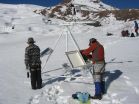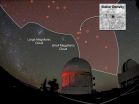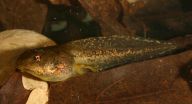(Press-News.org) 17.08.2015: Glaciers in Central Asia experience substantial losses in glacier mass and area. Along the Tien Shan, Central Asia's largest mountain range, glaciers have lost 27% of their mass and 18% of their area during the last 50 years. An international research team led by the GFZ German Research Centre for Geosciences and including the institute of the French Centre National de la Recherche Scientifique (CNRS) at Rennes University in particular, estimated that almost 3000 square kilometres of glaciers and an average of 5.4 gigatons of ice per year have been lost since the 1960s. In the current online issue of Nature Geoscience, the authors estimate that about half of Tien Shan's glacier volume could be depleted by the 2050s.
Glaciers play an important role in the water cycle of Central Asia. Snow and glacier melt from the Tien Shan is essential for the water supply of Kazakhstan, Kyrgyzstan, Uzbekistan, and parts of China. "Despite this importance, only little was known about how glaciers in this region changed over the last century" the principal investigator Daniel Farinotti explains. Most of the direct monitoring programs, that were shut down with the collapse of the Soviet Union, are resumed only today, and modern observation techniques often cover a limited time span only.
GFZ-researcher Farinotti and colleagues now present a reconstruction of the glacier evolution in the Tien Shan. "We combined various methods based on satellite gravimetry, laser altimetry and glaciological modelling" Farinotti says. "This way, we were able to reconstruct the evolution of every single glacier. Currently, the Tien Shan is losing ice at a pace that is roughly twice the annual water consumption of entire Germany."
Glaciers in Central Asia
Glaciers can store water as glacier ice over decades, and transfer winter precipitation into the summer months by releasing it as melt water. This is particularly important in seasonally arid regions, i.e. regions that have months with virtually no precipitation, since local water supply is then closely linked to meltwater availability.
Central Asia is the outstanding case for human dependence on water seasonally delayed by glaciers. Nowhere the question about the glacier state is linked so closely to questions of water availability and, thus, food security.
The pace of glacier retreat noticeably accelerated between the 1970s and the 1980s. Daniel Farinotti: "The long-term signal is clearly related to the overall rise in temperature". In fact, the study shows that the rise in temperature, and summer temperature in particular, is a primary control for glacier evolution in the region. "For Central Asia, this statement is less trivial than it might seem at first glance: Since the winter months in the region are very dry and the mountains are that high, glaciers receive most of their snowfalls during summer." Farinotti explains. "This means that an increased temperature contributes to both, increased melt and reduced glacier nourishment - and obviously, both contributes to glacier wastage."
By using the latest climate projections, which anticipate an additional 2 °C warming of summer temperatures in the period 2021 - 2050, the authors also provide a first outlook for the future evolution: Half of the total glacier ice volume present in the Tien Shan today could be lost by the 2050s.
INFORMATION:
Daniel Farinotti, Laurent Longuevergne, Geir Moholdt, Doris Duethmann, Thomas Mölg, Tobias Bolch, Sergiy Vorogushyn, and Andreas Güntner: "Substantial glacier mass loss in the Tien Shan over the past 50 years", Nature Geoscience, Advance Online Publication, 17.08.2015, DOI: 10.1038/ngeo2513
Photos in a printable resolution may be found here:
Fig 1: http://tinyurl.com/q4um95h
Glaciological field measurements on a glacier in the Jetim-Bel range, Kyrgyzstan. Systematic in-situ surveys as pictured are essential for providing ground truth data against which satellite observation can be compared. (Photo: D. Farinotti, GFZ/WSL)
Fig 2: http://tinyurl.com/qd4xgly
Two unnamed glaciers in the Chrebet Terskey range, Kyrgyzstan. The topographic control on glacier occurrence is striking: North-facing slopes are glacierized, whilst south-facing slopes are free of ice. (Photo: D. Farinotti, GFZ/WSL)
Fig 3: http://tinyurl.com/o45v539
North facing slope of the Jetim-Bel range, Kyrgyzstan. Glacier melt is an essential water resource in an otherwise dry environment. (Photo: D. Farinotti, GFZ/WSL)
Fig 4: http://tinyurl.com/pdv3h3l
A lake mirrors some fresh-snow covered glaciers in the Teskey Ala-Too, Kyrgyzstan. Yet the appearance is deceiving: Glaciers in the Tien Shan are losing mass at a rapid pace. (Photo: D. Farinotti, GFZ/WSL)
Lueneburg. Sustainability Scientists at Leuphana University of Lueneburg have devised a simple screening-based predicting procedure for region-specific environmental risks caused by veterinary antibiotics (VA). This procedure, called Usage Pattern-based Exposure Screening (UPES), makes use of utilization patterns of antibiotics in animal husbandry. By improving targeting, it enables the identification of particularly problematic antibiotic substances. It also enables the implementation of more advanced risk prediction tests, for example with the help of soil and water ...
DURHAM, N.C. -- We've all seen dewdrops form on spider webs. But what if they flung themselves off of the strands instead?
Researchers at Duke University and the University of British Columbia have now observed this peculiar phenomenon, which could benefit many industrial applications. As long as the strands are moderately hydrophobic and relatively thin, small droplets combining into one are apt to dance themselves right off of the tightrope. The discovery could form the basis of new coalescer technologies for water purification, oil refining and more.
The findings ...
Seasonal water shortages already occur in the Central Andes of Peru and Bolivia. By the end of the century, precipitation could fall by up to 30% according to an international team of researchers led by the University of Zurich. In a first for this region, the team compared current climate data with future climate scenarios and data extending back to pre-Inca times.
The population in the Central Andes already faces water shortages today. Now geographers at the University of Zurich have collaborated with Swiss and South American researchers to show that precipitation in ...
Over a 10 year period, the time that babies receive genetic testing after being diagnosed with diabetes has fallen from over four years to under two months. Pinpointing the exact genetic causes of sometimes rare forms of diabetes is revolutionising healthcare for these patients.
Babies with diabetes are now being immediately genetically tested for all possible 22 genetic causes while previously they would only get genetic testing years after diabetes was diagnosed and then the genes would be tested one at a time. Crucially, this means that the genetic diagnosis is made ...
Scientists on the Dark Energy Survey, using one of the world's most powerful digital cameras, have discovered eight more faint celestial objects hovering near our Milky Way galaxy. Signs indicate that they, like the objects found by the same team earlier this year, are likely dwarf satellite galaxies, the smallest and closest known form of galaxies.
Satellite galaxies are small celestial objects that orbit larger galaxies, such as our own Milky Way. Dwarf galaxies can be found with fewer than 1,000 stars, in contrast to the Milky Way, an average-size galaxy containing ...
We may view our memory as being essential to who we are, but new findings suggest that others consider our moral traits to be the core component of our identity. Data collected from family members of patients suffering from neurodegenerative disease showed that it was changes in moral behavior, not memory loss, that caused loved ones to say that the patient wasn't "the same person" anymore.
The findings are published in Psychological Science, a journal of the Association for Psychological Science.
"Contrary to what you might think -- and what generations of philosophers ...
WASHINGTON, August 17, 2015 -- Almost all of us have used some type of odor eliminator like Febreze to un-stink a room. These sprays can work wonders, but how do they actually work? Do they really remove the smell or just mask it? We explain the chemistry of odor elimination in this week's Reactions video. Check it out here: https://youtu.be/sNIIxzR-d_Q.
Subscribe to the series at http://bit.ly/ACSReactions, and follow us on Twitter @ACSreactions to be the first to see our latest videos.
INFORMATION:
The American Chemical Society is a nonprofit organization chartered ...
This news release is available in German.
Their results have now been published in the Nature journal Scientific Reports (doi:10.1038/srep13008) and could point the way toward improvements in hybrid solar cells.
The system they investigated is based on conventional n-type silicon wafers coated with the highly conductive polymer mixture PEDOT:PSS and displays a power conversion efficiency of about 14 %. This combination of materials is currently extensively investigated by many teams in the research community.
"We systematically surveyed the characteristic curves, ...
Millions of tons of road salt are applied to streets and highways across the United States each winter to melt ice and snow and make travel safer, but the effects of salt on wildlife are poorly understood.
A new study by biologists from Case Western Reserve University suggests exposure to road salt, as it runs off into ponds and wetlands where it can concentrate--especially during March and early April, when frogs are breeding--may increase the size of wood frogs, but also shorten their lives.
Wood frog tadpoles exposed to road salt grew larger and turned into ...
In addition to melting icecaps and imperiled wildlife, a significant concern among scientists is that higher Arctic temperatures brought about by climate change could result in the release of massive amounts of carbon locked in the region's frozen soil in the form of carbon dioxide and methane. Arctic permafrost is estimated to contain about a trillion tons of carbon, which would potentially accelerate global warming. Carbon emissions in the form of methane have been of particular concern because on a 100-year scale methane is about 25-times more potent than carbon dioxide ...




